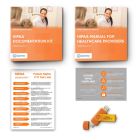
Similar to other healthcare or medical facilities, the majority of dental offices are run digitally these days. While technology makes the entire process for patients and staff easier, advanced tech also creates a more complex legal situation. Dental providers run a heightened risk of potentially violating HIPAA rules. HIPAA stands for the Health Insurance Portability and Accountability Act.
HIPAA is legislation that ensures both the privacy and security of a patient’s personal and protected health information. Complying with HIPAA means safeguarding patient’s information and reducing the overall chance of a data breach in your system. As security is a top priority within a facility, here is a HIPAA compliance checklist for dental providers to follow.
Know and Observe the HIPAA Security Rule
There are three parts to the HIPAA security rule, which includes three different aspects of security requirements. These requirements are technical requirements, physical requirements, and administrative requirements. Technical requirements for security include the technicality of communication—how information is transmitted and communicated electronically. There should be a controlled system with standard transmittance processes set in place in order to protect patients’ information.
The physical requirements under the security rule rely on the computer systems in place at a dental facility. These computer systems and their surrounding environment should be inaccessible to those who are not responsible for information imputation, meaning there should be procedures set in place to validate a person’s physical access to private information. Administrative requirements under the security rule ties into this procedure. Administrators are appointed to select a communications system that is compliant with HIPAA and are responsible as well to develop policies and protocols for compliance.
Be Secure Against Cybersecurity Threats
As mentioned above, healthcare and dental facilities have gone digital with recordkeeping and patient files. At the top of this HIPAA compliance checklist for dental providers lies an important task—knowing how to act under the HIPAA security rule. To best way to protect patient’s private information is to have a system of secure messaging as well as data encryption. Encryption of patient data is a requirement to appropriately protect sensitive information like SSNs, birthdates, addresses, or phone numbers. It’s also best to use passwords on computers in the office, and have secured and not open or public Wi-Fi network.
Ensure Proper Staff Education and Training
Having clear compliance protocols set in place is the very best way to protect patient information. Examples of such protocols would be not public broadcasting private information in the office and safely and quietly inputting private information in the computer. Employee error is a major cause of data breaches, so train staff under HIPAA’s privacy, security, and breach notification rules.
If you’re a dental provider searching for an education program, you’ve come to the right place. Gamma Compliance Solutions has all the necessary compliance materials for your dental facilities’ training needs. With our HIPAA compliance training, you and your staff can be aware and knowledgeable about required HIPAA regulations to be protected from any legal issues in the future.



